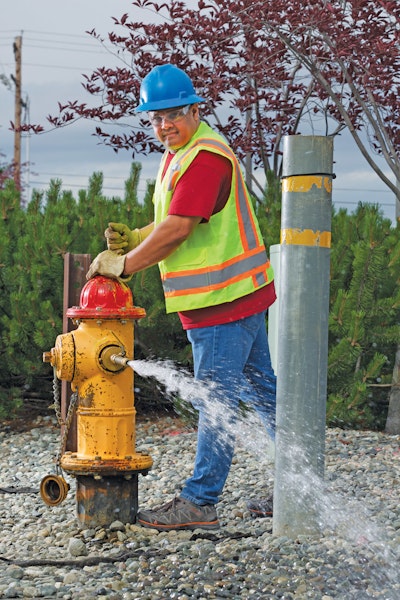
Systems maintenance foreman Earl Stewman of the Anchorage Water and Wastewater Utility opens the valve on one of 7,400 fire hydrants he’s responsible for maintaining across a 125-square-mile service area. (Photography by Brian Adams)
Earl Stewman is on a mission: Make sure the fire hydrants in Anchorage, Alaska, work when they’re needed — all 7,400 of them.
It’s a tall order, especially when the snow flies. Alaskan temperatures dip to 25 below zero, and an eight-member crew covers a 125-square-mile territory in a city of 290,000.
Fortunately, Stewman, an 11-year veteran of the Anchorage Water & Wastewater Utility is up to the challenge. In fact, he has built a solid career in the Operations and Maintenance Division, becoming systems maintenance foreman (hydrant operations) in 2014 and winning the 2016 Large Water System Maintenance/Operations Person of the Year award from the Alaska Water Wastewater Management Association.
An association news release about the award described Stewman as “a reserved gentlemen, respected by his crew and customers at AWWU alike. He takes his responsibilities and those of his crew very seriously. He has made it his personal mission to ensure the Anchorage hydrants are serviceable and provide sufficient pressure for public safety. Since taking over the hydrant crew two years ago, he has reduced the number of out-of-service hydrants from 166 to 80, with 50 of those being private hydrants.”
Stewman, a utilityman III, works with Distribution Operations to maintain water quality through flushing programs, the Engineering Department on construction of new hydrants, and Customer Service on providing hydrants of adequate size to accommodate contractors for street cleaning, landscaping and contract maintenance.
Legacy knowledge
“I was surprised to win the award,” Stewman says. “My goal has always been to do a good job of maintaining the 7,400 hydrants in the greater Anchorage area. To me, that meant getting the number of out-of-service hydrants down to less than 1 percent. You have to coordinate with a lot of people to repair, excavate, and replace the hydrants, and that’s what my crew and I are committed to doing. The award reflects a lot of hard work by a lot of great people.”
The award represents a major milestone in a career that saw Stewman follow his father to AWWU, Alaska’s largest water and wastewater utility with 52,000 commercial, residential and military water customers. He joined the ranks of 260 utility employees a decade after his father retired, bringing what hydrant crew member Marshall Kennon calls “legacy knowledge of operations and customer service.” Kennon adds, “You can’t grow up in the household of a utility worker without some of those smarts rubbing off.”
A five-year utility employee, Kennon services 820 hydrants in a territory that stretches from midtown 6 miles north to the Anchorage International Airport. “Earl knows a lot about hydrants and shares it with us, which is priceless. Often you can’t tell if a hydrant needs repair because it may look OK, so you have to know what to look for and what to test for to make sure it’s working, and then move on.”
Before joining the utility, Anchorage native Stewman did a variety of construction, maintenance and retail jobs. That included a 10-year stint with his then-wife running a general store in Crooked Creek, a remote village (population 105) about 300 miles west of Anchorage, accessible only by small plane or barge. He calls that “a real Alaskan experience, where temperatures could reach 60 below zero. I did a lot of hunting and fishing. We sold groceries, four-wheelers, snowplows and just about anything else customers needed, and we lived in an apartment above the store.”
Back in Anchorage, a friend saw an ad for positions with the AWWU. He and Stewman applied and got jobs. Stewman was determined to learn all aspects of the business. In time, he earned Water Distribution 2 and Wastewater Collections 2 certifications and made it a practice to study utility operations. AWWU operates the 35 mgd Eklutna Water Treatment Facility, the 24 mgd Ship Creek Water Treatment Facility, numerous wells, and three wastewater treatment plants.
Making the rounds
AWWU’s unique cross-training work culture facilitated his learning. The 90-member Operations and Maintenance Division has four crews: line cleaning, manhole/valve, excavation and hydrants. Employees make their way around each crew over three- or four-year periods, so they become well-versed and ready to respond to any situation.
While Stewman’s first job was cleaning waterlines, he rotated around the job circuit and ended up on the hydrant crew, long before he thought about becoming foreman. “I realized all the work involved in maintaining these thousands of hydrants,” he says. “Plus, I reasoned that my boss, Eric Braendel, would retire in a few years. That’s why I decided to focus my energy on hydrants, so I could eventually move up, which is exactly what happened.”
Today, Stewman’s crew is responsible for all hydrant repairs and maintenance, funded under a $1 million budget provided by the Anchorage Fire Department. His maintenance crews work four 10-hour days that overlap Monday through Friday. Upon arriving at 6:30 a.m., Stewman meets with the team and hands out assignments for the day. Then he takes calls about broken hydrants and other issues, handles work orders, and lets the Fire Department know which hydrants are out of service — an all too common issue.
Challenging weather
Given all the snow and ice Anchorage gets in winter, drivers sometimes lose control and hit the hydrants. The hydrants, supplied by American Valve & Hydrant and Mueller, are designed to break cleanly and leave the waterlines undisturbed so that water is not wasted.
Sometimes, snowplows strike the hydrants. In other cases of extremely cold weather, groundwater can seep into a hydrant at the base; then freeze; expand; and damage valves, rings, rods or other internal parts.
When those incidents happen, crew members shut the hydrant down and file an excavation request so they can repair it. With lines running 10 to 12 feet below the frozen ground (and the deepest being 23 feet down), the task can be daunting, yet Stewman remains undeterred.
“Earl is a good foreman — reliable and one of my go-to guys who I can always count on,” says Tim Forbus, superintendent of the Operations and Maintenance Division, who supervises 22 employees, including three foremen. “He can make a decision and stick to it without caving in to peer pressure. That’s essential to making things run well. His crew likes working for him because he’s so straightforward. They know exactly what he’s thinking. And he lets them do their jobs without micromanaging.”
Beyond his strong management style, Stewman’s focus on hydrants has made a big difference. Forbus notes that the city had many out-of-service hydrants, both public and privately owned. Since Stewman took over the hydrant crew, the number of such hydrants has fallen steadily to about 1 percent of the total.
The private side
Utility workers typically shovel out private hydrants and do some routine maintenance, but the owners — auto body shops, small manufacturers, or big companies like BP or Conoco — are responsible for major repairs. Many of these hydrants are out of service because the owner could not or did not spend money: up to $3,000 for repairs and up to $15,000 for replacement. Stewman had a better idea.
“We had plenty of standard parts we weren’t using, so Earl came to me and said, ‘Let’s use them to fix these private hydrants,’” Forbus recalls. “And that’s just what we did. We took them apart, replaced leaking rings and such, so now they’re available if the Fire Department needs them. Because of the success of our hydrant program, we’ve earned an A1 insurance rating — the highest there is. That saves us money on our premiums. It’s a real tribute to the job Earl and his crew do and one of the main reasons I nominated him for the Person of the Year award.”
Hydrant crew member Christopher Blastick is equally high on Stewman: “Earl is one of the most professional bosses I’ve ever worked for. He lets you use your skills and encourages you to self-learn, but he’s always there to answer your questions.”
For Blastick, such support is crucial. He has serviced about 2,900 hydrants in his three years working for Stewman, covering three territories. Stewman even helped him put on a presentation about hydrants for the 2016 AWWMA conference. Blastick demonstrated how the crew checks hydrants’ health by tapping them to detect any water inside that could freeze and crack the hydrant. If that happens, crews open the hydrant, pump out the water and repair any leaks. That can be time-consuming, but it’s essential for preventing widespread damage from extreme cold.
Hydrants, bees get personal care
Although Stewman appreciates the recognition, he much prefers the day-to-day work with his crew, which he calls “the best in the utility,” and the nonstop opportunities to learn new techniques and technologies. An avid outdoorsman, he likes hunting, fishing and four-wheeling. At present, his passion is beekeeping: He has run seven hives and gives most of the honey to co-workers.
Growing up, he had a neighbor who kept a beehive and let him sample the honey. Thirty years and a lot of research later, Stewman finally got his own hives, which he treats like the hydrants he services — with plenty of care. Before winter, he feeds the bees well, wraps the hives with polyurethane insulation and provides a moisture box to get them through the winter.
As for the future, Stewman plans to spend the rest of his career with the AWWU. “We have a great work environment, great leaders and an excellent team. Because people move from crew to crew, they don’t get stale or burned out. The Fire Department is good to work with, and I really get satisfaction knowing that we’re making a contribution to keeping Anchorage residents safe.”
The hollow sound of safe hydrants
Throughout the year, Earl Stewman’s hydrant crew performs a hands-on process of tapping fire hydrants to make sure they ring hollow — a sound that’s music to their ears.
“We usually slap the hydrant’s large steamer nozzle with our hand to see if we get a deep hollow sound, which would indicate that the hydrant barrel has little to no water left in it,” Stewman says. “The guys call that ‘bunging.’ If we hear a dense or sloshing sound, we know there’s water in there, most likely from a leak. Water in the hydrant will freeze and cause the hydrant to break and be out of service, something nobody wants, so we have to take action.”
If they find water in a hydrant, they immediately remove the bonnet (cap), pump it out, check the bonnet assembly and valves for leaks, and make any needed repairs. Winter poses more challenges because of the hard ground. Crews must clear snow from the hydrant, dig a 6-foot-diameter trench around it and get to work, draining water and defrosting the bonnets and other parts. Bunging can take a couple of hours if problems are found, but typically, it’s a fast slap-and-listen process.
Stewman’s busy crew does bunging on all of Anchorage’s 7,400 hydrants six to nine times per year, mostly in winter, to make sure the Fire Department can access the hydrants under any conditions. Most of the summer work involves a variety of hydrant repairs.
Each member of Stewman’s crew is responsible for about 900 hydrants. Stewman says, “Keeping the hydrants in working order is especially important. In 2016, we seem to have had more apartment and house fires than I’ve seen in several previous years, so having water to fight them is vital.”







